As an owner, the last thing you want to see is your axolotl getting sick & lying on a corner of your aquarium. And to save it from reaching that level, you need to install filters.
Installing filters alone is not all; you need to complete the cycle so that the beneficial bacteria stay active in the nitrogen cycle.
For the best result, you can use a sponge filter or a canister filter. The sponge filter is best for small tanks, and the canister filter is best for big tanks.
Without further ado, let’s see why do axolotl needs filters and the hidden benefits of it.
Do axolotls need filters?
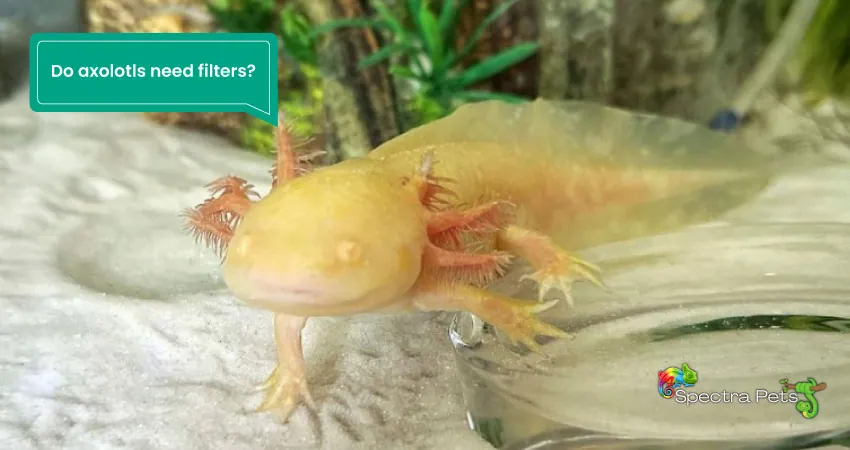
Yes, it’s crucial to install a filter in an axolotl tank as this hardy species generates a good amount of waste every single day.
If you don’t add a high-quality filter, then the water quality will fall drastically and your axolotl health is under threat. Because the ammonia level will go high which will directly affect the lovely pet.
Moreover, you have to change the water daily to keep the water quality at the standard level, which is nearly impossible and unnecessary.
When planning to install a filter, you need to ensure it does not create too much wave. Because when the water becomes wavy, your axolotl has to waste a lot of energy to swim around. And on top of that, they like being in calm water.
Why filters are a must for an axolotl aquarium?
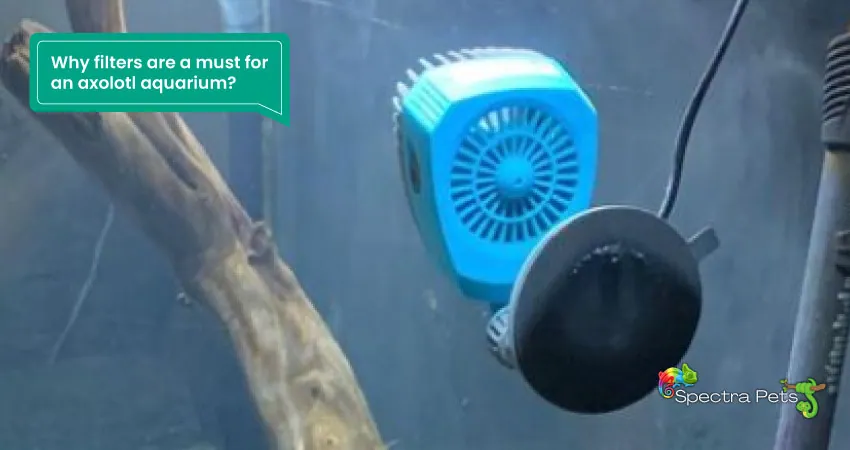
Importance of Nitrogen Cycle in Axolotl Aquariums
The nitrogen cycle is crucial in maintaining a healthy environment for axolotls in an aquarium. The continuous eating and excreting of waste by the axolotls will increase the level of ammonia in the water, which can be toxic to the animals if left unchecked.
The nitrogen cycle involves several stages, each carried out by different groups of beneficial bacteria. The first stage is nitrification, which is the process by which ammonia is converted into nitrite (NO2) by nitrifying bacteria. The next stage is denitrification, where nitrite is converted into nitrate (NO3) by denitrifying bacteria. Finally, the nitrate is either taken up by plants or removed from the tank through regular water changes.
In an established and properly cycled aquarium, the nitrogen cycle works seamlessly, with the waste produced by the aquatic animals being broken down by the beneficial bacteria. This keeps the levels of toxic waste products such as ammonia and nitrite within safe levels for the aquatic life in the tank.
Role of Filters in Nitrogen Cycle
Installing a filter in an axolotl aquarium provides a suitable environment for nitrifying bacteria to establish themselves. These bacteria convert the toxic ammonia into nitrite (NO2) and then into nitrate (NO3).
While nitrates are not harmful to axolotls, excessive levels can interfere with the process of breaking down ammonia. Removing nitrate is comparatively easy as you can simply change the water or add a few aquatic plants.
This process is known as the biological filtration process and can take up to 12 weeks to complete.
Seeded Filters
If you have limited time, you can use a seeded filter, which can shorten the biological filtration process to just three weeks. After adding water and installing the filter, add ammonia to the tank and wait for the bacteria to colonize the filter.
After three weeks (with a seeded filter) or twelve weeks (without a seeded filter), test the water to see if the ammonia and nitrite levels have reached 0 parts per million (ppm). If the levels are 0 ppm, it means that the nitrogen cycle has been successfully established.
Maintenance of Nitrogen Cycle
It is important to keep the nitrate levels below 40 ppm and to change 20% of the water in the tank every week to maintain a healthy nitrogen cycle for your axolotls. Regular monitoring and maintenance of the nitrogen cycle will ensure that the axolotls remain healthy and happy in their aquarium.
What types of filters are available for the axolotl tank?
Just like another captive aquatic animal, you will find three types of filters for the axolotl tank. And these are chemical filters, mechanical filters, and biological filters.
Chemical Filtration
The chemical filtration process is a chemical additive process that wipes out unnecessary molecules like ammonia, chlorine, heavy metals, or phosphates from the axolotl tank water.
Here, activated carbon plays the main game by removing pollutants. If you use this process to keep the water clean, the water needs to be changed from time to time.
Mechanical Filtration
Mechanical filters are simply machine filters that do the job of removing hard and big waste particles from the water. They remove the waste before it gets dissolved in aquarium water. However, these filters can’t reduce the percentage of ammonia and nitrate. And you have to clean the filter at least every 2–3 weeks to keep the filtration process smooth.
Biological Filtration
Biological filters mainly ensure that the nitrogen cycle inside the axolotl tank remains active. These filters are loaded with biological media that works as the home of beneficial bacteria. These bacteria are also known as nitrifying bacteria that break down both ammonia & nitrite into nitrates.
What is the best filter to use for axolotl?
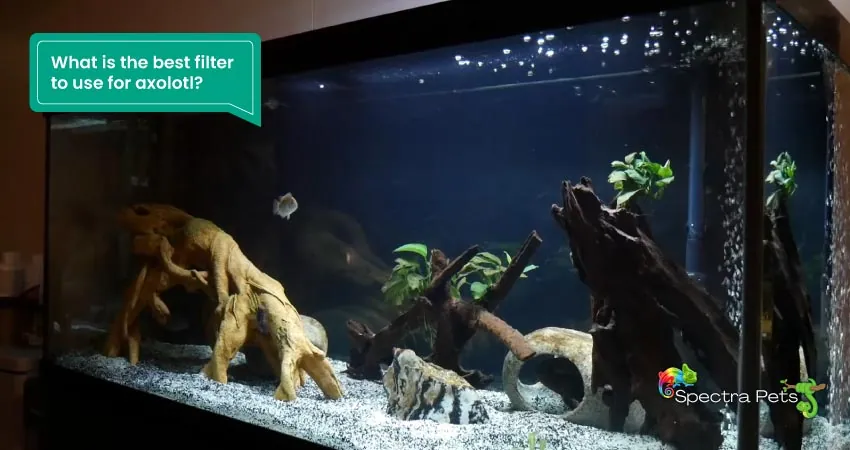
For an axolotl tank, you can use either a sponge filter or a canister filter. Both of them are good, but the canister filter surely wins the race between the two.
Let’s have an idea of how they work…
Sponge filter
The sponge filter’s main mechanism is to take water through layers of sponges with the help of an air pump. Though they are slightly noisy, they are suitable for an axolotl tank.
Mainly they trap larger size particles and the cleaning process is quite easy. While cleaning you have to use aquarium water. Otherwise, the beneficial bacteria will be dead & the nitrogen cycle will be broken.
In terms of power, they are less powerful and produce less current, which keeps your axolotl stress-free. These filters are good for beginners who would like to keep their axolotl in a smaller tank.
However, you need to remove the big chunk of poop & excess food from the tank when there’s a sponge filter. With a few days’ gaps, the water changing is a must.
Canister filter
For the best quality water, you should install a canister filter. Usually, they are a bit complex both in terms of cleaning & functioning.
This filter takes out water from the axolotl aquarium and then takes it to the canister. After filtering the water, it again passes the water into the aquarium.
3 different chambers are working inside this filter. And they are sponge filter chamber, carbon chamber, and coarse filter loaded with biomedia.
Different elements like ammonia, chlorine, and other toxic organic elements are easily removed by these filters. Plus, they can filter a high amount of water in less time. You can use a 60 gph for a 20-gallon aquarium.
Luckily, they come with a spray bar so the issue of powerful current on the water can be maintained easily. You will also get a flow rate adjuster that will make the job easy.
Though they are extremely efficient and keep nurturing the beneficial bacteria which ensure perfect water quality for a happy & healthy axolotl but has some cons too.
When it comes to price, they are a bit costly. Adding to that, the cleaning process is a bit difficult due to the multiple chambers with different elements. All of these chamber components have to be changed after a few weeks to keep the bacteria functioning & to prevent any clogging from dirt.
Looking at every detail, the Canister filters are best for big-size axolotl tanks.
Can You Keep Axolotls Without A Filter?
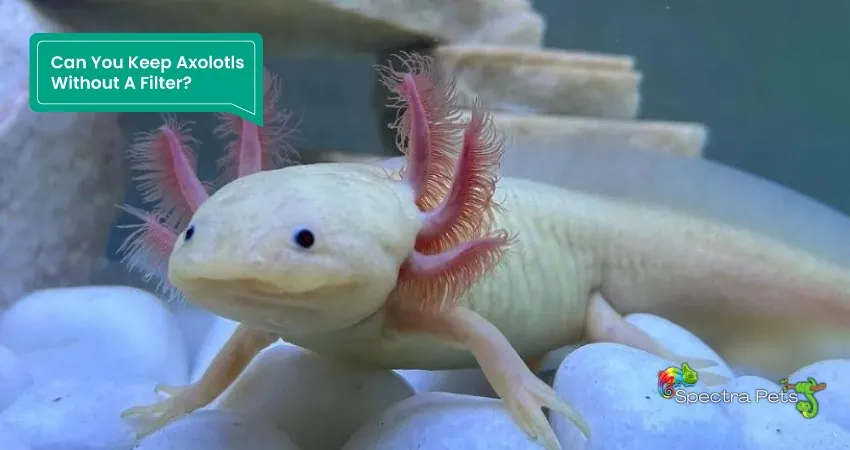
In terms of petting axolotls without any filter might sound risky but in reality, it’s possible. But it would be hard for you to maintain the optimum water quality.
Natural plants like aquatic plants would be an outstanding option to reduce toxic like ammonia. But as long as there’s no powerful mechanical filter, the water-changing process has to be done regularly.
As you can see, biological filters lessen the burden of the water-changing requirement to a certain level. The best part is that the biological filter does not even look like a filter as it adds aesthetic value to the axolotl tank.
How long can an axolotl go without a filter?
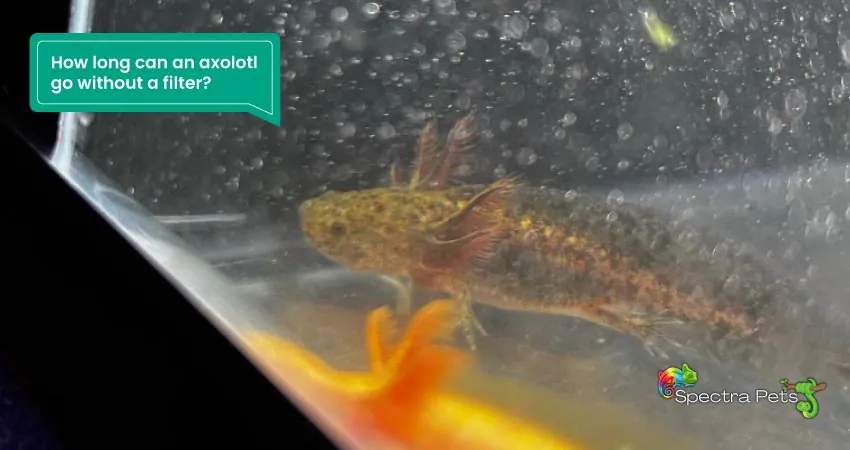
When it comes to surviving without any kind of filter in the axolotl tank then they can go for a long time if the water is changed frequently. However, if you don’t change the water daily and there’s no filter then it would turn out deadly for your cute pet.
If your filter becomes broken, or you have not yet bought and cycled one, then the only way to keep them alive is to change the water in the tank every day. So that the ammonia level stays below the danger level.
To stay on the safer side, always keep a look at the ammonia level. You can easily buy them from any online shop at a low price.
Do axolotls need bubblers Or Air Pumps?
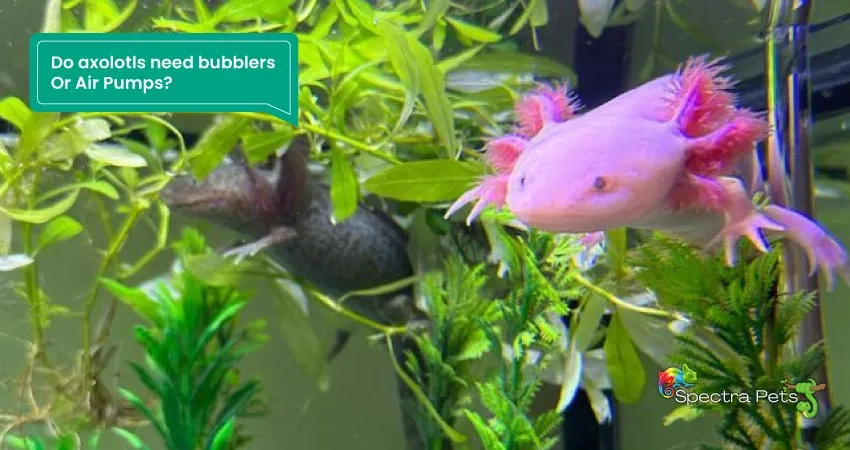
Thanks to the multiple breathing ability of axolotls which give them the freedom to live without the help of bubblers or air pumps in their aquarium.
So you don’t need bubblers to give extra support to the axolotl. These magnificent animals can easily breathe using their gills, skin, and rudimentary lungs.
Even if you find that your axolotl are taking little gulps of water on the surface, it does not mean that there is no oxygen in the water.
As long as the filters are there, you can stay relaxed about it because it keeps the water fresh and cool, which ensures a high amount of oxygen.
Can I turn my axolotl filter off at night?
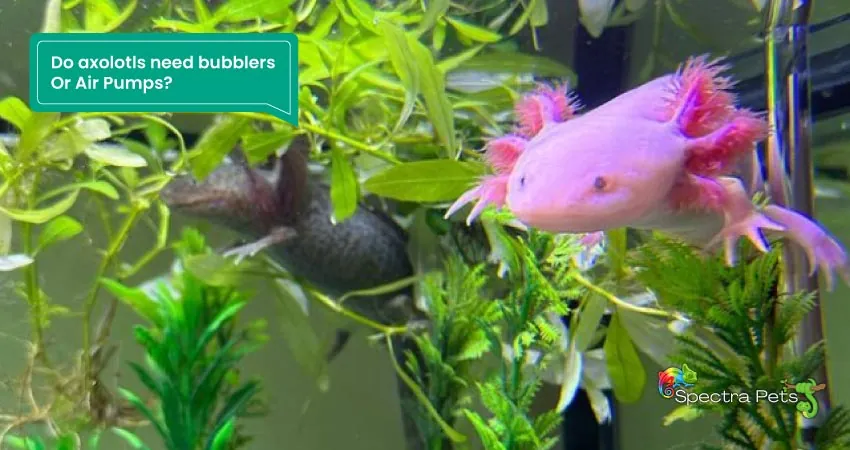
No, you should not turn off the axolotl filter at night or any other time of day. Because the nitrogen cycle has to be smooth. The moment you turn off the filter, the water cycling will be stopped, and the bacteria won’t survive without a constant oxygen supply and won’t be able to clean the water anymore.
Final words
Petting a sensitive animal like an axolotl requires effort. Luckily the filtering process makes half of the job easier for the owner as they ensure the formation of good bacteria to break down ammonia.
Throughout this post, you saw how these filters add value to your precious axolotl’s health.
Hopefully, you now have a full idea of why do axolotl needs filters in their aquarium.
Read Next:
